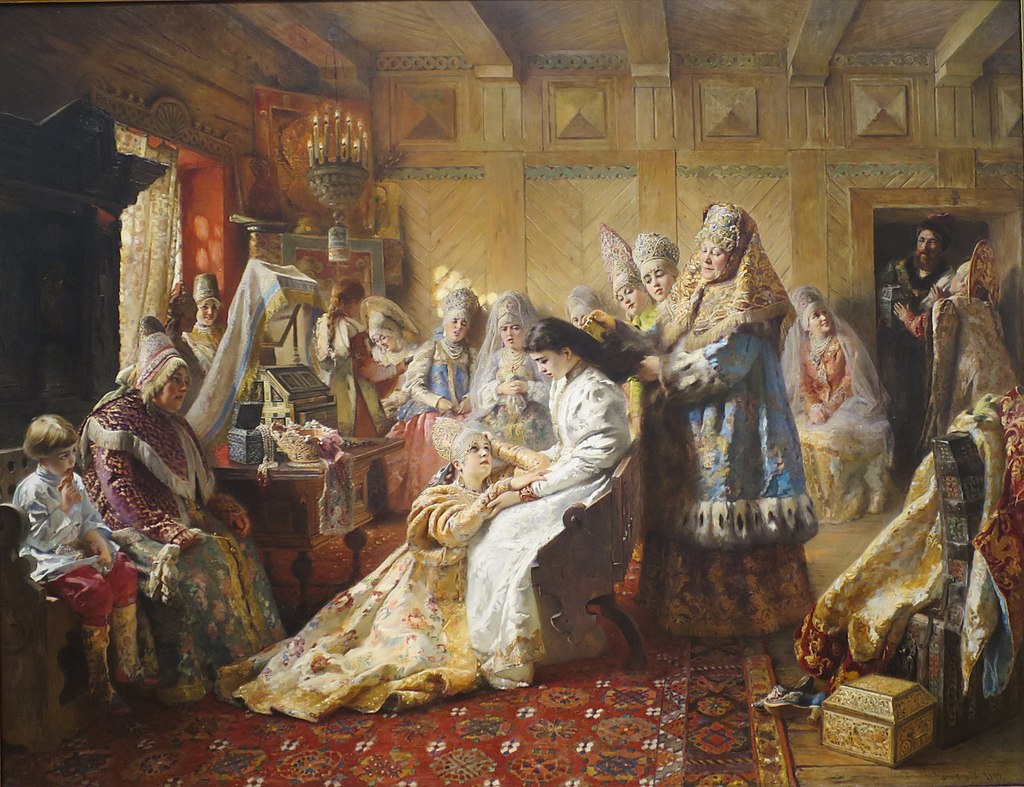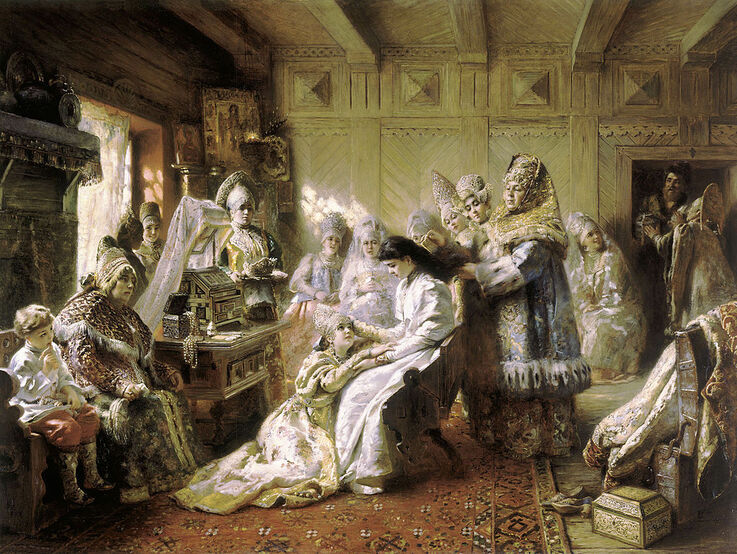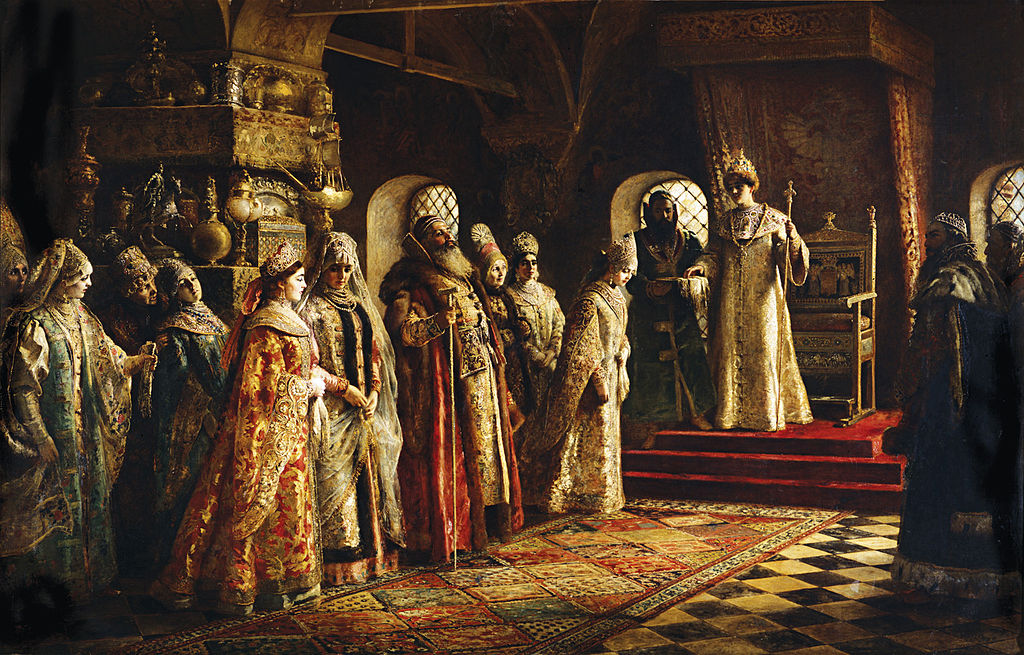|
Where? Gallery 17 of the Legion of Honor Museum
When? 1889 What do you see? A life-size depiction of a scene before a 17th-century Russian wedding. The girl dressed in white in the center is about to get married to the tsar. She looks pale, and her sister is at her feet. The bride did not choose her partner, and she is not looking forward to the wedding and the rest of her life. She will have to give up her happy life as a teenager and faces a life in which she will have to do whatever the tsar demands. Most of her female friends and family members surrounding her share the somber mood. The mood is in stark contrast with the sumptuous, colorful outfits of the wedding guests. Tradition prescribes that only women can be present while the bride is prepared for the wedding. An exception is made for the little boy sitting on the left. However, the man entering the room – possibly the bride’s father - is not welcome and is urged to leave the room. Backstory: The bride’s name is Maria Ilyinichna Miloslavskaya. She is about to get married to the 18-year old Tsar Alexis I. Makovsky created two versions of this painting. The first version is on display in Serpukhov`s Museum of History and Art. This version is much less colorful and almost eight times smaller than the version in the Legion of Honor. Makovsky used his second wife as the model for the bride in this painting. When this painting was traveling through the United States in 1893, Michael Henry de Young bought the painting. He left the painting for the museum that was eventually named after him, the De Young Museum, which forms together with the Legion of Honor Museum the Fine Arts Museums of San Francisco.
Bridal theme: Makovsky enjoyed painting the 17th-century life of the Russian upper class. He created several portraits and large paintings on this topic. Among his paintings is also The Choice of the Bride in the Museo de Arte de Ponce in Puerto Rico. In this painting, potential brides for the tsar line up and the tsar can choose who he wants to marry. The young women have no say in this as the tsar’s word is law.
Who is Makovsky? Konstantin Yegorovich Makovsky was born in 1836 in Moscow. The artistic gene ran in the family as his father and brothers were artists as well. He was one of the most successful Russian painters of his generation and loved to spend his earnings on traveling across the world. He died in 1915 in Saint Petersburg.
His works are a combination of the Realist and Academic art styles. He painted a variety of themes, including historical and mythological topics, genre pieces, and portraits. His most famous mythological work is probably The Judgment of Paris in the Faberge Museum in Saint Petersburg. A nice example of Makovsky’s portraits is the Portrait of Varvara Bibikova in the Hermitage Museum in Saint Petersburg.
Fun fact: The size and colors make this painting look very impressive. One is inclined to think at first glance that Makovsky painted a happy occasion. But a better look at the bride tells a different story. This story is emphasized by the faces of the other guests in the room. They do not look happy either. However, Makovsky did not make an effort to express much emotion on these faces. They mostly look dull and expressionless.
While Makovsky was an accomplished portrait painter, he clearly did not make a big effort in painting meaningful faces and expressions. Instead, he focused on the coloring, which was his main interest during this stage of his career. Interested in a copy for yourself? Poster
9 Comments
Where? Room 2 of the Musée d’Orsay
When? 1863 What do you see? A beautiful Venus is born from the foam of the sea. It looks as if she has just awakened from a deep slumber. She languidly rests her head upon a small wave that is beginning to form on the far right. The waters seem to conform to her twisted contrapposto, perfectly following the shape of her waist. Upon first glance, her eyes are shut. But a closer look reveals that they are half-open, pointed upwards as she looks into the crook of her right elbow. Her golden hair flows from beneath her left arm, floating beside her in the blue-green waters. Above her is a pastel sky decorated with thin clouds and five cherubs that are celebrating and announcing her arrival with horns made of seashells. The three cherubs closest to her face peer over her body with playful curiosity, arms stretched out, perhaps preparing to wake her. Backstory: Alexandre Cabanel exhibited The Birth of Venus in the Paris Salon in 1863 in a “Salon of Venuses”. During this time, many artists were painting female nudes shrouded in the mythology of the birth of Venus. The European idealized female nude, a tradition that traces back to the Venus of Urbino by Titian, was experiencing a revival in the 19th century in works like Cabanel’s, as well as the Grande Odalisque by Ingres, and the Maja Desnuda by Goya. The mysticism of the story gave artists room to produce semi-erotic works without offending the public. Cabanel’s Venus is posed in a much more provocative way than Olympia by Manet, but because of Manet’s more realistic and confrontational take on his nude, he received a great deal of criticism in the same year.
What is contrapposto? Contrapposto is a pose that was developed by the Greeks. In contrapposto, the figure rests its weight on one leg and bends the other. The axis of the shoulders and the hips are positioned in opposite directions to create a sense of dynamism and depth. This creates a natural resting pose that makes the figure come alive.
Who is Alexandre Cabanel? Alexandre Cabanel was a French painter born in 1823 in Montpellier, in the south of France. When he was seventeen years old, he enrolled in the Ecolé des Beaux-Artes in Paris. Following his first exhibition in 1844, Cabanel was awarded the Prix de Rome. His work was quickly popularized at the Paris Salon. Cabanel primarily painted in the Academic style and drew inspiration from the Rococo art movement. His works centered around classical, religious, and historical themes. The Birth of Venus, his most famous painting, was exhibited at the Paris Salon and later purchased by Napoleon III. In his later life, Cabanel served as a juror for the Salon and returned to the Ecolé des Beaux-Artes as a teacher. He died in Paris in 1889 at the age of 65. Fun fact: Following the creation of the original, Alexandre Cabanel sold reproduction rights to Adolphe Goupil, an art dealer and publisher. Working with copyist Adolphe Jourdan, Cabanel was able to produce numerous replicas of his take on The Birth of Venus. One of these replicas is on display in the Dahesh Museum in New York. Another one belongs to the Metropolitan Museum of Art but is not on permanent display. |
Categories
All
|
- Home
- Blog
-
Museums
- Alte Pinakothek
- Art Institute of Chicago
- Baltimore Museum of Art
- Barber Institute of Fine Arts
- Bargello
- Barnes Foundation
- British Museum
- Church of Sant’Anastasia
- Cleveland Museum of Art
- Courtauld Institute of Art
- Detroit Institute of Arts
- Frans Hals Museum
- Galleria Borghese
- Gallerie dell'Accademia
- Getty Museum
- Guggenheim
- Hermitage Museum
- Kunsthistorisches Museum
- Kunstmuseum Basel
- Legion of Honor Museum
- Louvre
- Mauritshuis
- Metropolitan Museum of Art
- Musee d’Orsay
- Museum of Fine Arts in Boston
- Museum of Modern Art
- National Gallery in London
- National Gallery of Art
- National Museum in Poznań
- Norton Simon Museum
- Ny Carlsberg Glyptotek
- Palace of Versailles
- Palazzo Pitti
- Palazzo Vecchio
- Petit Palais
- Philadelphia Museum of Art
- Prado
- Pushkin Museum
- Ravenna Art Museum
- Rijksmuseum
- San Diego Museum of Art
- Santa Maria delle Grazie
- St. Peter's Basilica
- Städel Museum
- Statens Museum for Kunst
- Tate Britain
- Tate Modern
- Timken Museum of Art
- Uffizi
- Vatican Museums
- Wallace Collection
-
Artists
- Altdorfer
- Anguissola
- Berlin Painter
- Bosch
- Botticelli
- Boucher
- Bronzino
- Bruegel the Elder
- Brunelleschi
- Cabanel
- Caillebotte
- Canova
- Caravaggio
- Carpeaux
- Cezanne
- Cimabue
- David
- Degas
- Delacroix
- De Maria
- Donatello
- El Greco
- Fontana
- Fra Angelico
- Fragonard
- Gauguin
- Gentileschi
- Gericault
- Gonzalez-Torres
- Goya
- Hals
- Hogarth
- Hokusai
- Ingres
- Leonardo da Vinci
- Lippi, Filippo
- Longhi, Barbara
- Lorrain
- Makovsky
- Manet
- Massys
- Matisse
- Merian
- Michelangelo
- Mochi
- Modigliani
- Monet
- Panini
- Parmigianino
- Perugino
- Picasso
- Pisanello
- Raphael
- Rembrandt
- Renoir
- Reynolds
- Rivera
- Rodin
- Rubens
- Scultori
- Seurat
- Steen
- Tintoretto
- Titian
- Toulouse-Lautrec
- Turner
- Uccello
- Van der Weyden
- Van Dyck
- Van Eyck
- Van Gogh
- Van Hemessen
- Vasari
- Velazquez
- Vermeer
- Veronese
- Vigée Le Brun
-
Locations
- Books
- About Us








